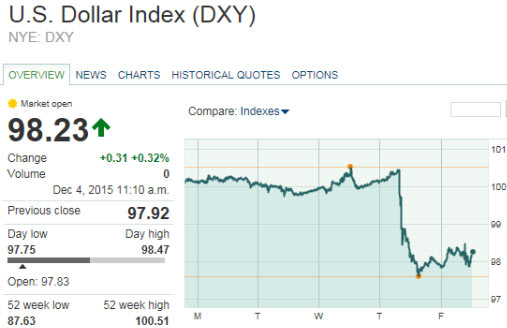The past week has to be one of the most volatile yet surprising, both up and down, in a while for gold - so where is the gold price headed next?
On Black Friday, gold took a beating to become one of the best "sale items" on offer, as it hit $1,055.90 per ounce and the U.S. Dollar Index (USDX) closed above the 100 mark.
Then by Monday, Nov. 30, gold had risen to close at $1,064.50 in New York trading on a stronger dollar. On Dec. 1, it was mostly unchanged, bouncing between $1,065 and $1,070.
But the real action for gold prices lay ahead...
What Is Happening to the Gold Price Now
By Wednesday, Dec. 2, gold began to sell off around 8 a.m., dropping from $1,067 to $1,055 by 10 a.m.
The most likely culprit was the strength in the U.S. dollar. That same day, the USDX (or DXY) traded all the way up to 100.51 intraday, which put pressure squarely on the gold price.
Here's how the DXY looked over the past five trading days:
But that wasn't the only source of pressure. Sentiment worked surreptitiously in the background to weigh even heavier on gold.
That same day saw the SPDR Gold Trust ETF (NYSE Arca: GLD) experience an outflow of 2.4% in the number tonnes of gold held by the trust. A large single-day sell-off of this magnitude points towards capitulation.
Interestingly, there was a notable divergence between gold and gold stocks.
While the gold price was hitting a new low, the HUI Gold Bugs Index had managed to stay 5% above its own lows. According to Sentimentrader.com, this has happened three other times since 1996.
And get this - each of those times, the HUI gold stocks index averaged gains of 20% over the next three months.
So based on the HUI's behavior in the same circumstances over last 20 years, we could be in for a healthy run-up in gold stocks starting now.
Then came Thursday, Dec. 3...
[mmpazkzone name="in-story" network="9794" site="307044" id="137008" type="4"]
How Draghi Moved Gold Prices
That's when European Central Bank head Mario Draghi disappointed markets.
Instead, Draghi dropped the deposit rate - the rate charged to banks leaving their cash at the ECB - to minus 0.3% from the previous minus 0.2%. He also extended the quantitative easing program, whereby the ECB buys €60 billion monthly of bonds, by six months into March 2017.
Many had expected to see that program upped by about €20 billion to a total of €80 billion monthly.
Draghi and U.S. Federal Reserve Chairwoman Janet Yellen almost certainly coordinated their efforts.
The strong U.S. dollar has been a strain on U.S. multinationals who lose on exchange rates when repatriating profits and face headwinds selling their products and services priced in the higher dollar.
Here's what my Yahoo! Finance screen looked like at the end of that day:
The euro surged by a whopping 3% against the U.S. dollar (the most in nearly seven years), and the dollar fell by more than 2% after being within 1% of a new high. Gold gained almost 0.7%, and the U.S. markets tanked.
A speech delivered by Yellen, reinforcing the likeliness that the Fed will raise rates in two weeks, served to knock the dollar index down from nearly 100.50 to about 97.6 in a matter of hours, and to limit gains in gold.
But Friday shrugged that off.
Where Gold Is Going
Here's what the gold price action looked like on Friday morning:
Gold rose rapidly and steadily from 8:30 a.m. at $1,060 to the $1,087 level, a $27, or 2.5%, gain in a matter of hours. By midday, the HUI was up 10.4% from the start of the week.
The most plausible explanation was that there were few sellers left and short covering switched into high gear.
Last week, I told you about how the recent Commitment of Traders (COT) reports showed very low short positions by commercial traders (smart money) as gold's been hitting new lows. That signals they feel we may be near a bottom in gold. I also pointed out how that could mean a gold rally into the new year.
Well, it looks like that may just be what we're getting now.
In the week ahead, it will make sense to keep a close eye on the COT reports, as well as the action in the U.S. Dollar Index.
If there is considerable follow through and a sustained shift in sentiment, then gold and gold stocks look like they are about to heat up.
Stay informed on what's going on in the markets by following us on Twitter @moneymorning or liking us on Facebook.
The Gold Mining Revolution: Technological advancements in gold mining have been stagnant, but one tiny Canadian company is about to change that. Its special extraction method will slash production costs and send gold prices soaring. In fact, this nano cap could disrupt the entire industry...





